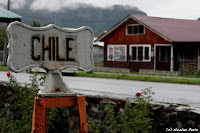 It's 7am on Thursday. The clouds are still hanging to the surrounding mountains. In a valley of the Cordillera, the small village of Futaleufu slowly wakes up. Smoke from the wood stoves is escaping from the small wooden color-washed houses. It is not cold as such; it is just very humid. Leaning over my steaming coffee, I regularly take a look out the window. The rain has not stopped since late yesterday afternoon. Clouds do not know borders; I arrived in Chile but nothing changed. Instead, with the weather coming from the Pacific ocean, I do not expect changes today or in the next days.
It's 7am on Thursday. The clouds are still hanging to the surrounding mountains. In a valley of the Cordillera, the small village of Futaleufu slowly wakes up. Smoke from the wood stoves is escaping from the small wooden color-washed houses. It is not cold as such; it is just very humid. Leaning over my steaming coffee, I regularly take a look out the window. The rain has not stopped since late yesterday afternoon. Clouds do not know borders; I arrived in Chile but nothing changed. Instead, with the weather coming from the Pacific ocean, I do not expect changes today or in the next days.
It's been two days since I left Bariloche. In Argentina, I hitch-hiked with uneven success, but thanks to Cesar, Carlos and Pedro I managed to reach each of the steps set (Esquel, Argentina and Futaleufu, Chile). It makes me remember when I was hitch-hiking in the Northwest United States, and specially on the wonderful and wild Pacific coast.The climate is probably helping. But the traffic here is even less dense. On the Chilean side, there is a car coming every hour and a half! Fortunately, there is a 95% chance it stops and picks me up. Hence, the average waiting time is just as good.
 |
| Click on the map to enlarge |
Between Futaleufú and the Carretera Austral I was led by Walter, happy to present the region, to name lakes and streams, to describe the colors of the water and its incredible transparency also. Not going through the whole way, I then had to walk two hours before joining Villa Santa Lucía, on the Carretera. En route, I crossed a jeep camper. Far, I don't know what intuition convinced me that they were French. The closer they drove, the more I recognized a European plate with a French flag. I stopped them and there we go: Patrice and Véronique, two smiling and enthusiastic Normans, told me about their road-trip throughout South America for two or three years. Having already spent six months doing what I intend to do on foot in one and a half months, I understand they have planned much longer!
 Arriving at Villa Santa Lucía, on the Carretera, I thought and hoped there will be more traffic. No. I had to wait an hour, still in the rain, before Lucas stops. As drivers decide to stop or not, when you hitch-hike, you also have a second and a half to decide whether or not to get on board. Twice in the US, I went saying to myself with uncertainty "let's go, it should work!". Lucas had an strong accent that I could only from time to time understand and a strange behavior. Anyway, the incessant rain and the prospect of arriving safely at night made me jump in. He begun by sharing his sandwich with me. NIce. But then he also shared the bottle of Vermouth (Martini kind of)! Here I begun to understand why I couldn't understand everything. With alcohol, articulation was not his best asset anymore. Once driving his van, Lucas was dreaming himself as Sebastien Loeb [the nine-time French rally world champion]. After two days hitch-hiking in the rain and wind, I tried not to see that very nearly bumped into a goat, a public work truck, the back of a cow and a number of potholes. Instead, I even managed to escape my attention and sleep a bit thanks to the heating of the van.
Arriving at Villa Santa Lucía, on the Carretera, I thought and hoped there will be more traffic. No. I had to wait an hour, still in the rain, before Lucas stops. As drivers decide to stop or not, when you hitch-hike, you also have a second and a half to decide whether or not to get on board. Twice in the US, I went saying to myself with uncertainty "let's go, it should work!". Lucas had an strong accent that I could only from time to time understand and a strange behavior. Anyway, the incessant rain and the prospect of arriving safely at night made me jump in. He begun by sharing his sandwich with me. NIce. But then he also shared the bottle of Vermouth (Martini kind of)! Here I begun to understand why I couldn't understand everything. With alcohol, articulation was not his best asset anymore. Once driving his van, Lucas was dreaming himself as Sebastien Loeb [the nine-time French rally world champion]. After two days hitch-hiking in the rain and wind, I tried not to see that very nearly bumped into a goat, a public work truck, the back of a cow and a number of potholes. Instead, I even managed to escape my attention and sleep a bit thanks to the heating of the van.
Arrived safely in La Junta, I left the next morning. Patrick and Rose dropped me in Puyuhuapi where I stayed overnight. It is a charming little village on a lake with a small "Danger Tsunami" sign... oh yeah! In fact, the Pacific reaches the bottom of the small fjord. Very remote village which horizon is blocked by clouds, it really looks like the end of the Earth. It is far and wild, but it is beautiful! It is cold and wet, but this is adventure!

No comments:
Post a Comment